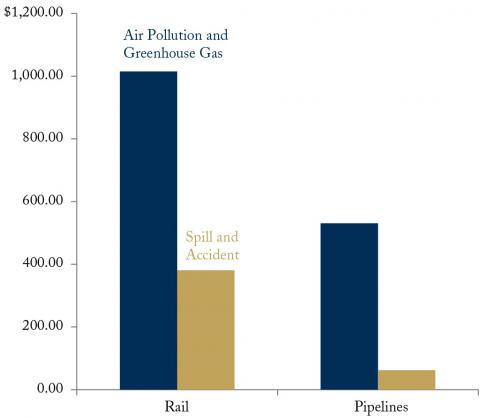From: Karen Clay, Akshaya Jha, Nicholas Muller, and Randall Walsh
To: Concerned Canadians
Date: October 5, 2017
Re: External Costs of Transporting Petroleum Products by Pipelines versus Rail
In the debates across North America about long-distance transportation of petroleum products, by rail and by pipeline, most of the attention has been paid to spill and accident costs. Relatively little of the conversation has been focused on air pollution and greenhouse gas costs. Pipelines come out ahead of crude-by-rail on both scores.
Using an array of detailed US data, we constructed new estimates of the risks of all four factors in the shipment of crude oil from North Dakota in 2014, a year in which roughly half the volume of crude oil moved by rail and half by pipelines.
Although numbers have fallen subsequently, in 2014 US railways shipped roughly 16,000 carloads a week of crude oil and other petroleum products. According to the National Energy Board, Canadian crude-by-rail exports reached their peak in December of that year at 5.4 million barrels, averaging 1.1 million barrels per week for the whole year. Assuming, as the Canadian Association of Petroleum Producers has, that there are 600 barrels of oil per railcar, about 1,800 carloads a week of Canadian crude oil was exported to the US by rail that year. That number may be higher, as some Canadian petroleum products were shipped to Canadian refineries and other destinations. And the cancellation of the Energy East pipeline by TransCanada today will only increase the attractiveness of the rail shipment option for destinations in Quebec and the Maritimes.
We used data on locomotive diesel consumption, pipeline pumping station electricity consumption, emission factors for locomotives and power plants and an integrated assessment model which maps county level emissions to costs for counties affected by the emissions.
The analysis has two main findings, which are shown in Figure 1. First, air pollution and greenhouse gas costs are substantially larger for rail than for pipelines. For shipments of crude oil from North Dakota to the Gulf Coast in 2014, the air pollution costs and greenhouse gas costs are nearly twice as large for rail as for pipelines. Second, air pollution and greenhouse gas costs are much larger than spill and accidents costs. We find that air pollution and greenhouse gas costs are more than twice as big as spill and accident costs for rail and more than eight times as big for pipelines. As Canadian governments, regulators and the courts deliberate over approving pipelines, they should be aware of the broader social costs of the alternative of shipping more of Canada’s oil by rail.
Karen Clay is a professor of economics and public policy at Carnegie Mellon University and research associate at the National Bureau of Economic Research (NBER), Akshaya Jha is an assistant professor of economics and public policy at Carnegie Mellon, Nicholas Muller, an associate professor in economics at Carnegie Mellon University and research associate at NBER, and Randall Walsh, is an associate professor in economics at the University of Pittsburgh and a research associate at NBER.
To send a comment or leave feedback, email us at blog@cdhowe.org.






